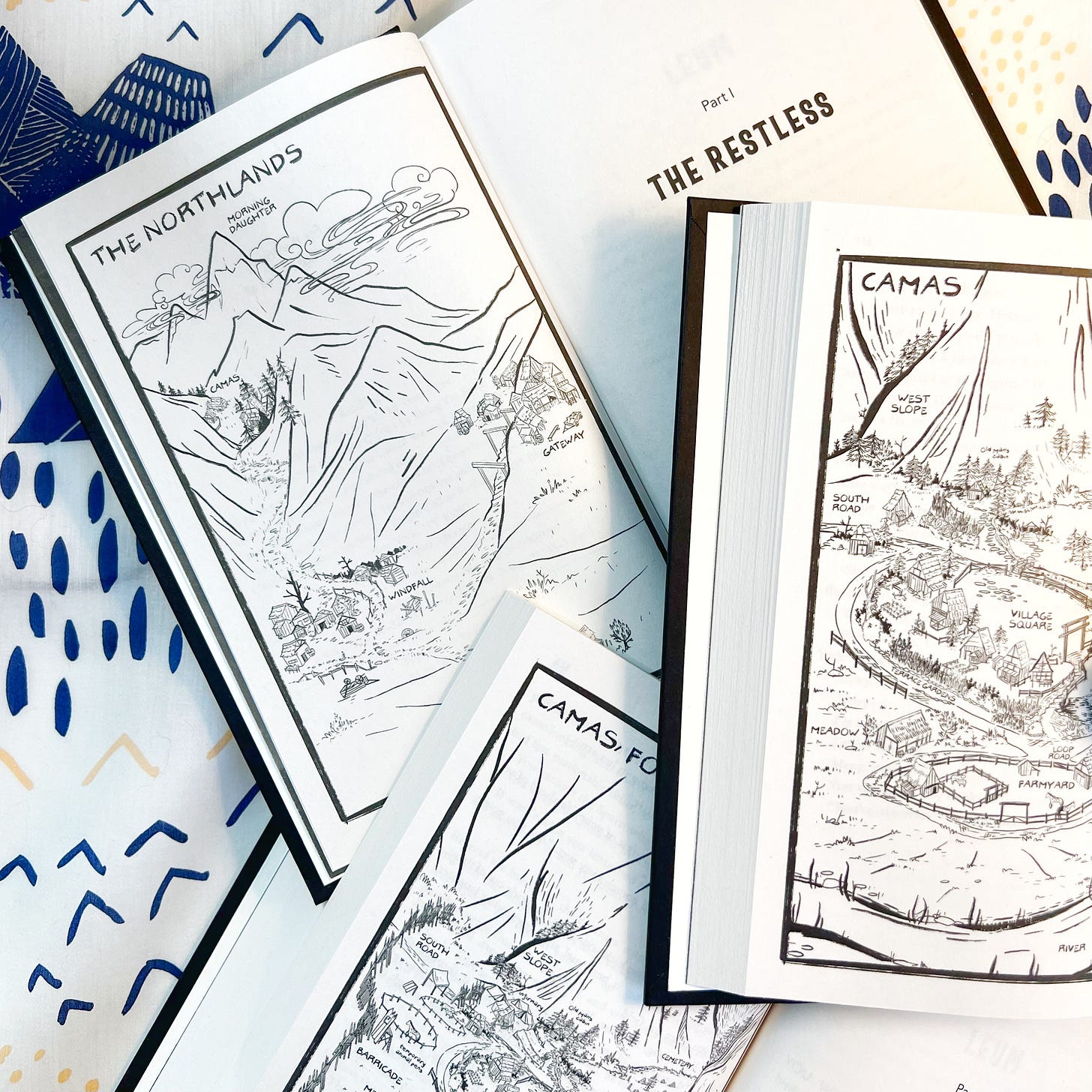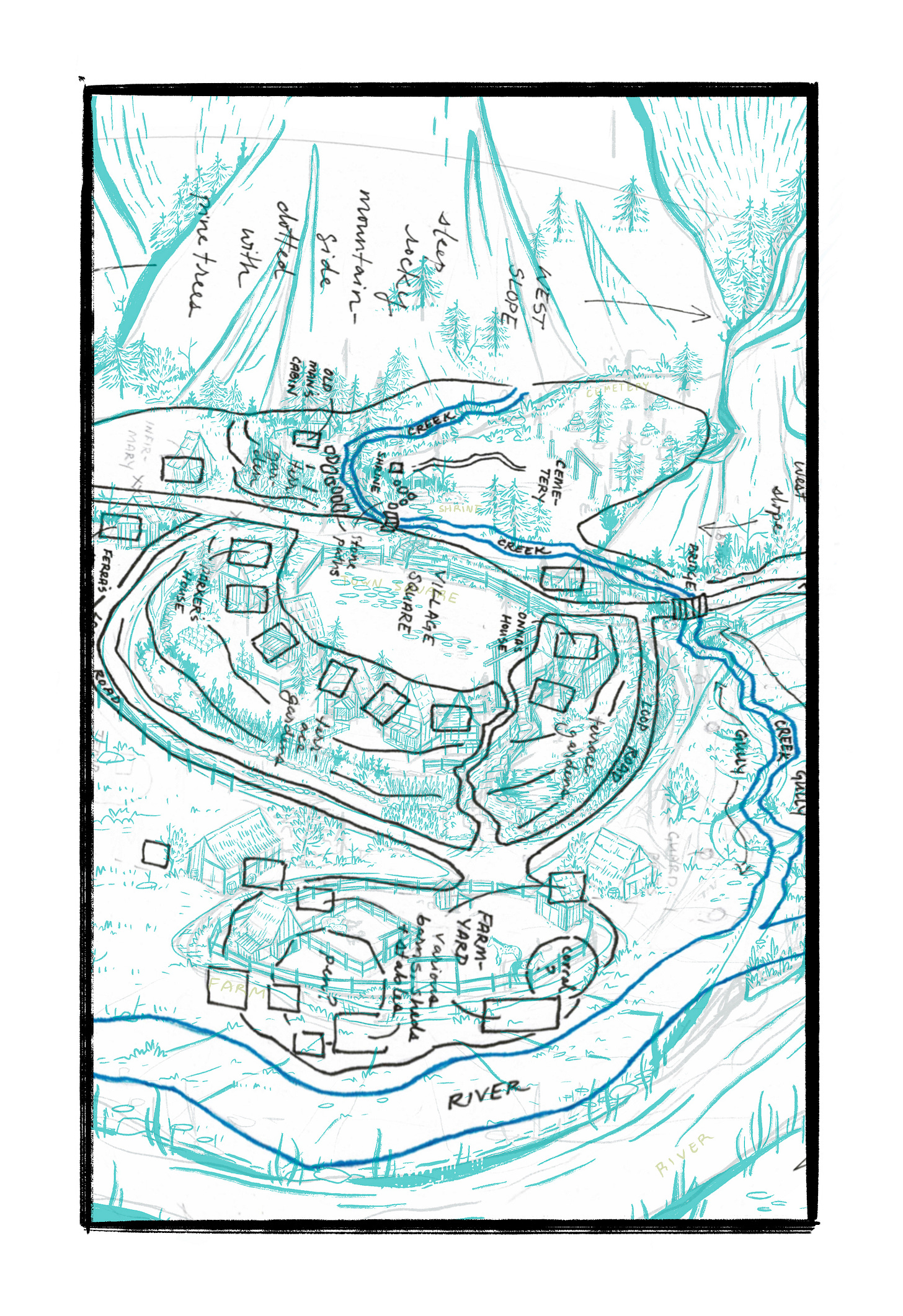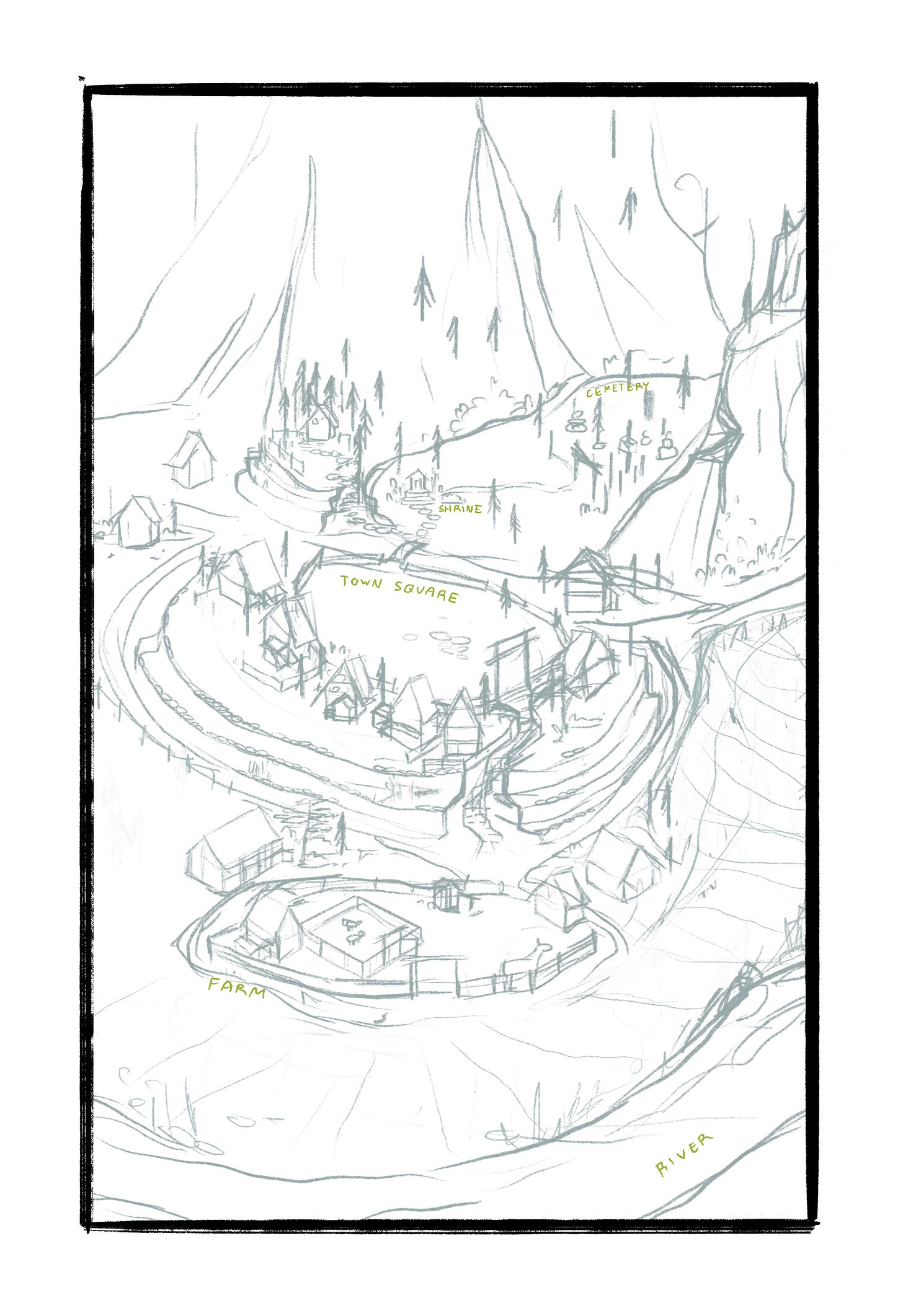Dear Reader,
We’re a month out from the publication of Kindling, and I’m so grateful to everyone who has bought, read, requested, reviewed, or otherwise celebrated the launch of this bold little book. Thank you for all your support!
I love maps in books, but because the story of Kindling is so focused on the defense of a single mountain village, it didn't make sense to include a world map or even a map of the entire country. Instead, the maps in Kindling correspond to the action of each part of the story: first the northlands, where the kindlings find each other, then the mountain village of Camas, before and after the kindlings arrive to protect it. I think it provides a really unique and intimate look at the world of Kindling, with a wealth of details you might not otherwise see!
We were lucky enough to have artist Shing Yin Khor draw the maps for us, and I'm so in love with the way they came out. The perspective! The linework! The detail! I've been a fan of Shing's since reading The Legend of Auntie Po, their award-winning graphic novel about a Chinese American girl growing up in the logging camps of the Sierra Nevada in 1885, and when we were thinking of commissioning this series of maps for Kindling, they were the very first person who came to mind.
Today, I'm so pleased to be featuring a short interview with Shing, because it provides a fascinating look into their thinking and process, plus some bonus sketches of their Kindling maps-in-progress! Read on below!
An interview with Shing Yin Khor
TC: In one of our very first communications, you requested a “shitty napkin drawing” of the world of Kindling, a phrasing I found absolutely delightful because it’s so evocative and perfect—I felt like I could picture exactly what you were thinking! Can you walk us through the process of creating the maps for Kindling? What information or inspiration did you have to pull from? How did you get from my napkin drawings and battle plans to the beautifully rendered maps that appear in the book?
SYK: I like "shitty napkin drawing" because it actually does communicate what I need, and I think as writers, we sort of instinctively understand what that is? It's that brain dump of raw imperfect information we quickly sketch when we are trying to figure out how our worlds work in actual space - and as a mapmaker, that's exactly what I need - a physical grounding in YOUR world.
Here is where those "shitty napkin drawings" actually have a very practical purpose - they are actually the very bottom reference layer of my art. Obviously the maps are a different perspective from the top-down view, but I actually physically skew them to provide the new perspective, so everything is actually positioned in the location you might imagine, accounting for perspective.
Obviously your original sketch has been skewed and distorted a bunch, but you can actually see that your locations line up with the final map really well.
You also sent me great references with wonderful details! The very first draft of the map is just about making sure things look right and make sense, in regards to space. Then I get to do the fun work of populating the world. I started from the points of reference you sent, and went down a few rabbitholes about Shirakawago, that village in the Japanese Alps and barricade construction methods. I don’t often directly reference them(this is a fantasy book, after all); I just let my newly acquired knowledge inform what I’m drawing when I’m drawing it.
TC: One of my favorite things about your maps is that they feel very lived in, as if the characters have only momentarily vacated the premises, and any second now they’ll reappear to pick up their belongings and continue their everyday lives. For example, there’s a slight change between the two maps of the village in Parts II and III, where the crops that dotted the hillside in the first map have been harvested in the second, which so beautifully and subtly evokes a flurry of activity, a change in season, a passage of time. For you, what goes into all those little details? What’s your approach to making a map feel less like something static and strictly expository and more like something that’s alive?
SYK: I think that a good map is indistinguishable from being its own narrative device - as a cartoonist, I think I just naturally assume that of course maps are not information, but histories of people and spaces. Even if a map of this sort does not have people, I think that it should still attempt to tell the story of the people who live there.
I think it might be a spoiler for your book to say why the change happens(or why we return to Camas twice), but narratively, it makes sense that crops would be harvested and stockpiled at this time. And of course, in the course of every day life, trees just get cut down, fences move…the terrain changes, even in fairly short periods of time. I loved little details that you left me like one of the houses becoming an infirmary - being able to draw a bunch of temporary tents was very satisfying.
TC:I LOVE maps. I use topo maps while I’m hiking, I pick up maps of tourist attractions when I’m traveling, and when I’m reading about real life places I like to look them up and zoom way way way out until I reach a recognizable name or landmark so I can slot it all into place in my mind. I think I like the way that maps orient me in my own world. They show me the shape of things, the relationships between them, where I stand in all that space. I’m curious about your own relationship to maps. In your experience, what makes a good map? What other intentions or purposes might a map have, beyond the practical? Have you come across any truly great maps in your life?
SYK: I think maps can be a perfect blend of narrative and data and communication of not just physical history, but also emotional histories(and that’s what I think makes a good map). They feel like a way to explain the ways our world works, but maps are also inherently political and opinionated artifacts of the times they are made in, and that is deeply fascinating to me..
I think I am also of the last elder millennial generation that really did use actual paper maps while first learning how to drive and navigate the world, so there’s just something about maps that is intrinsically linked in my brain to the process of discovering new things. I think I’m also a person who is very visually oriented but…not that imaginative? I love maps and infographics because they are very clear and logical ways to organize my thoughts and ideas.
As far as truly great maps - I am pretty obsessed over Jo Mora’s maps and have been for a couple years now. He has an amazing way of blending narrative and humor into informational maps that are so aesthetically pleasing and compelling. I could look at the little details of his maps for hours(I have).
TC: I first encountered your work through your Eisner-winning graphic novel, The Legend of Auntie Po, a marvelous mingling of history and folktale about a Chinese girl growing up in the logging camps of the Sierra Nevada in 1885, but you’ve also got a map-making keepsake game called A Mending, and in your latest newsletters you’ve talked about getting deeper into puppetry. What else are you working on? Where is your creativity currently leading you?
SYK: Hilariously, I keep on being led towards maps! I am one of the two Creators in Residence with the Los Angeles Public Library next year, and the project that I pitched is a series of maps about Los Angeles that map personal histories and some Los Angeles histories! The LAPL has been interwoven into the past two decades of my life in Los Angeles, and I think it is such an incredible cultural institution, so It’s really rewarding that they wanted to commission this project from me!
I am also heading deeper down the marionette rabbit hole, and I’m currently in Alabama carving a series of puppets based on Edward Topsell’s History of Four Footed Beasts.
Of course, I am also simultaneously working on my next graphic novel, but that is such a slow process that I am not sure I can really talk about it yet, because it won’t see the light of day for a few more years.
Thanks so much to Shing for taking the time to answer all my nerdy questions about maps, and of course for the beautifully rendered world of Camas and the northlands! Be sure to check out their work at shingyinkhor.com or find them on Instagram at sawdustbear!








